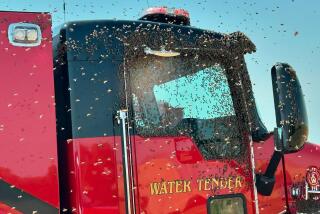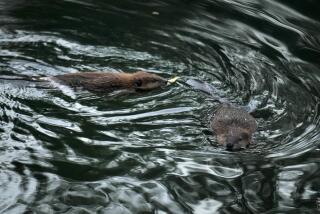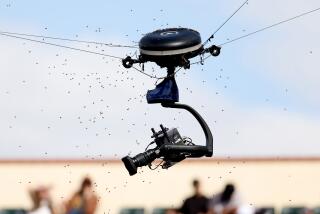3 Professors Enjoy Honey of a Project
Certain sounds just don’t sit well with most people. The whine of a dentist’s drill. A sputtering airplane engine. The drone of angry bees.
For three professors at Cal State Fullerton, however, fear is a mere buzzword, and the drone of bees the sweetest of sounds. In fact, twice a year, Gene Jones, Jack Burk and Charles Frazee whip the 350,000 or so bees that inhabit seven research hives at the university’s arboretum into a frenzy, then putter about in the eye of the humming tornado with obvious delight.
So what’s the attraction? “I suppose it’s to see if you’re smarter than the bees,” said Frazee, a history professor who has kept bees as a hobby for 40 years.
The hives also serve a higher academic goal. Burk, who is a professor of botany, uses the hives to teach about apiculture. Jones, also a professor of botany, is conducting research into the role bees play in the reproductive processes of plants--”specifically, how their color vision and preference for colors affect their pollination activities.”
That the professors’ periodic forays into the hives can net as much as 350 pounds of honey--sold to benefit the arboretum--is a fringe benefit of the whole operation, Jones said.
As he explained it, though, the honey-gathering operation helps to illustrate certain aspects of the intricate ecological system he and his students are exploring.
Bees produce several types of food to meet the needs of the different types of bees in the hive, Jones said. Worker bees create and consume honey, breaking the sucrose of the nectar they’ve gathered into the simpler sugars, glucose and fructose.
Pollen, which the workers have stored in “pollen baskets” on their legs, is mixed with honey to make a dough-like substance called “bee bread,” which mature bees feed to the larvae developing in the “brood box” at the bottom of each hive.
The workers also create the delicacy of the hive, “a very complex food that contains a lot of vitamins and minerals,” Jones said. Called “royal jelly,” this is the exclusive diet of the queen, who is sequestered in the brood box.
It’s the way the raw materials are gathered--the old business about the birds and the bees--that gets plant professors interested in insect behavior, Jones said.
“Plants can’t reproduce by themselves in most cases,” he said. They rely on the wind, or “living organisms.” Hummingbirds are helpful in plant reproduction as are certain other insects and small mammals, Jones said. “But very frequently the living organism is a bee.”
Each morning, Jones explained, a hive sends out scouts to look for sources of nectar and pollen.
“They’ll investigate lots of things--flowers, things that have floral type odors.” Once they find something that has a certain quality of food, they’ll go back to the hive and communicate that location to other “recruit” bees.
The recruit bees then head out for a day of foraging. When a bee finds a targeted flower, it wriggles inside and slurps up the nectar. At the same time, the bee is getting dusted with pollen. As it travels from flower to flower, pollination occurs--”the male pollen grain is transferred to the female receptive part of the plant, called the stigma . . . and fertilization takes place,” Jones said.
What Jones is trying to figure out is how the bee uses color--in addition to odor and other cues--to identify the flowers it winds up entering.
“We know that the three primary colors for bees are blue, ultraviolet and yellow. What we were trying to learn, specifically, is their color preferences. The second thing we’re doing is trying to find out if color preference is a learned behavioral trait or an inherited behavioral trait.”
Using arrangements of carefully colored plastic flowers containing a sugar water “reward,” Jones and the students he works with have found that in spring, summer and early fall, bees prefer blue over yellow and ultraviolet. In wintertime, however, this shifts, and they have a preference of yellow over blue and ultraviolet.
Jones isn’t sure whether the bees learned to prefer yellow in the winter because there are more yellow flowers in the winter--and thus they have a better chance of finding nectar if they look for that shade--or if they simply perceive the colors differently because the quality of light changes from season to season.
The next phase of research may answer those questions Jones said. “We’re now going into a much more detailed set of experiments. We’re setting up observation hives. We’re going to mark every single bee with a number attached to its thorax, so we’ll be able to see if there’s any innate preference,” or if the bees learn which color is likely to offer the most reward.
“Right now what we’re doing would have to be classified as pure science. What we hope is that as we learn more about bees’ behavior, we’ll be able to provide some good information to help the multibillion-dollar beekeeping industry--which is particularly important here in California. . . . It could help honey production as well as help farmers to more effectively pollinate crops.”
And Jones hopes that the information he learns about bees in the controlled environment of the arboretum will make his studies of plant reproduction easier when he gets back to studying plants in the field, he said.
In the meantime, Jones and his colleagues must also take care of the less esoteric aspects of beekeeping--such as honey gathering.
Having pumped smoke into the hives (the bees instinctively gorge themselves with honey before evacuating what they think is a burning hive, and are therefore more docile), the professors systematically removed the honey filled frames, joking as they worked. Using a leaf blower to disperse any bees clinging to the honeycomb, they then loaded the frames into a pickup.
The next day they would use an electric hot knife to cut away the wax with which the bees had sealed in the honey, then put the frames in a centrifuge. The extracted honey will be sold in the arboretum gift shop.
During the operation, however, the whole question of bees’ awareness of colors arose again. As a photographer recording the honey gathering stood near the hives, decked out in his own blue and black jump suit, he began to realize that the bees--many of which had clearly not been fooled by the smokers--were paying more attention to him than to the professors. The professors he noticed, were wearing white.
“They’re naturally more aggressive towards black and blue and darker colors,” Jones said. “It’s just one of those curious things.”
Another curious thing is that attacking bees emit a chemical called “an alarm pheromone,” Jones said. So, when the photographer’s clothing was stung a first time, other bees zeroed in like kamikaze pilots on a sinking destroyer.
The photographer flung himself into branches of a grapefruit tree and flailed about, hoping to dissuade the gray cloud that bedeviled him. He shouted an obscenity as a squadron of militant honey bees divebombed the netted pith helmet covering his face. “Die! Die!” he urged, slapping his arms with his ski-gloved hands as a necklace of cameras thumped against his chest.
Although only one bee managed to penetrate his defenses, he emerged with his leather camera straps and ski gloves encrusted with stingers.
Jones said that it’s common for someone venturing into a swarm for the first time to find the experience less than pleasant.
“After the first time, though, it’s not a big deal. Everyone who works with bees gets stung. . . . Now I wouldn’t even call (gathering the honey) work. It’s sort of a fun time for the three of us.”






